Stonemaier Games are back with their latest big release. This time, it’s a card game, based on Pierce Brown’s books of the same name, Red Rising. It’s a game of strategy, timing, using your faction’s powers, and uniquely, ending the game with a strong hand. Sounds strange? Read on.
Right from the outset, I should state that I’ve never read the books. Heck, I hadn’t even heard of them. Luckily you’re here for a game review, not a literary one. Red Rising is very easy to learn to play. You could teach someone the turn structure and explain what they’re trying to do in five minutes. Even the setup is fast and smooth. I just timed myself, and from opening the box to having a four-player game setup ready to play took me 2m 11s, and that was even with a quick check of the rules to make sure I’d dealt the right amount of cards. How many of your big box games are that fast?
Decisions, decisions
In Red Rising, you’re playing from a hand of cards to a board on the table. Those cards activate abilities when you play them, and they’re also worth points if they’re in your hand at the end of the game. I’m a big fan of dual-use cards, and I’m delighted to see them in another new game. When you score your hand at the end of the game, the values of your cards are dependent on the other cards you’re holding. Some will give you a big points bonus for being in the same hand as others, some will reduce your score for the same thing.
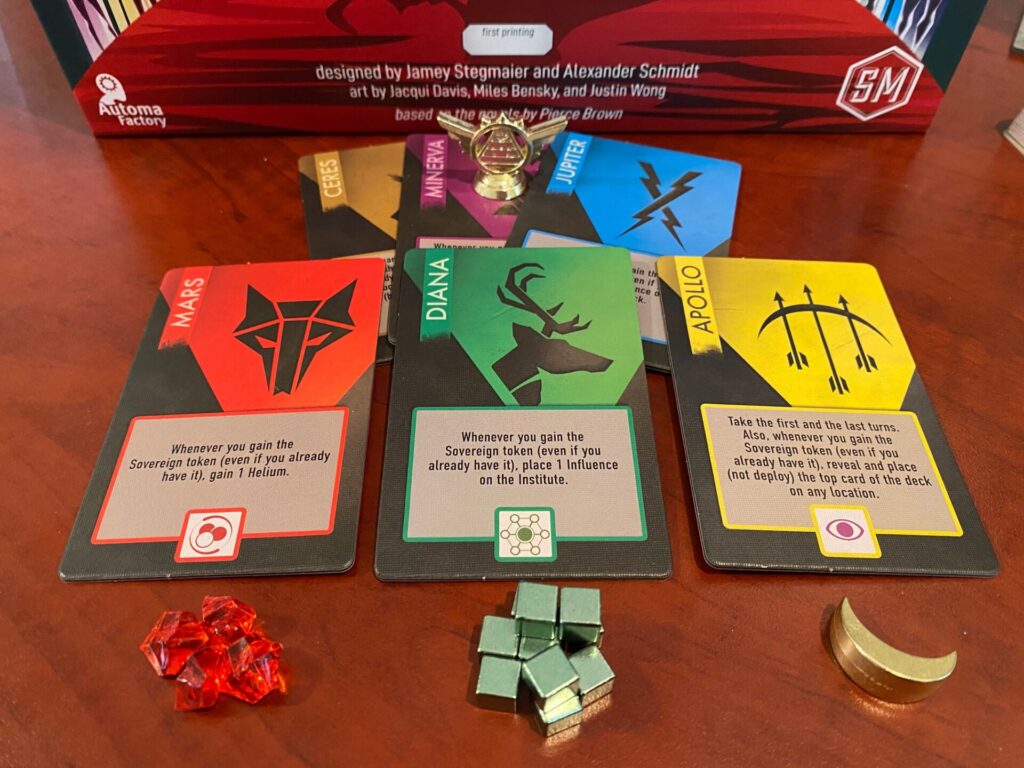
It makes gameplay really tricky at times, especially if you’re in your first couple of plays. It’s all-too-easy to look at your starting hand and think “wow, these cards are perfect, I don’t want to play any of them!”, but then you realise that by hanging on to those cards (which you’re perfectly entitled to do), you can’t advance in the three scoring areas as fast as you’d like to. Therefore you can’t trigger the end of the game before your opponents have boosted their scores, making holding onto those cards pointless.
That’s infuriating, yet utterly compelling.
Gone, but not forgotten
In many card games you’ll play a card and then it’s lost, gone, sacrificed to the gods of the discard pile. Your only hope of ever seeing it again is if a discard pile gets shuffled and recycled. In Red Rising, however, when you play a card to the top of one of the four locations, it just sits there, teasing you. The gorgeous gold leaf* on the gold cards glinting, teasing you, tempting you. “You want me don’t you? You want me in your hand again“.
*collector’s edition only
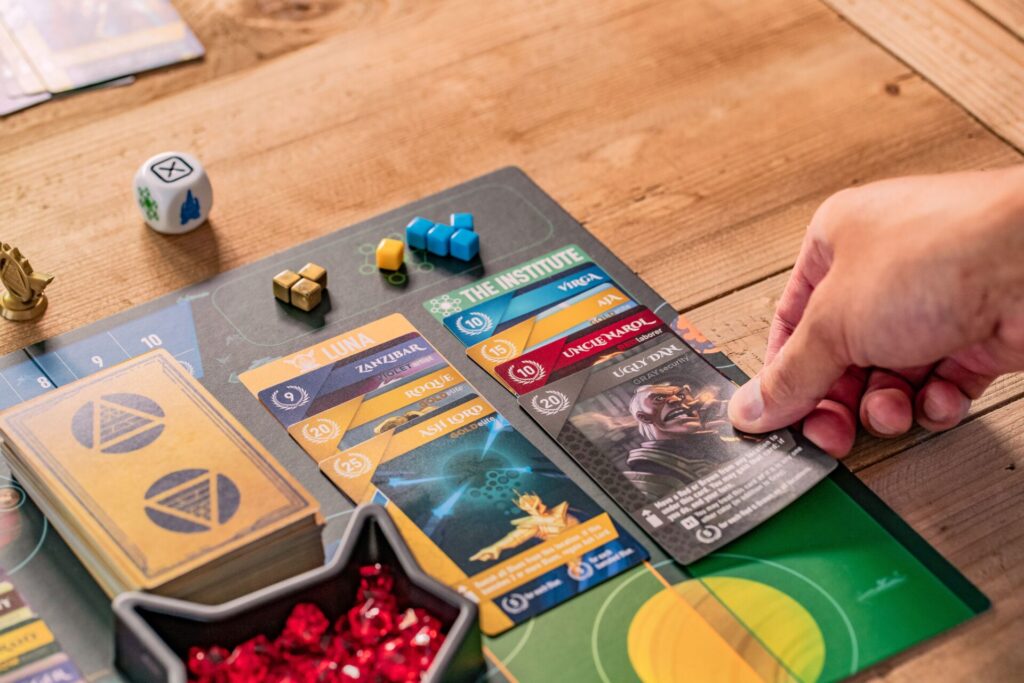
Ahem. When you play a card to a location, you get to pick one up from one of the remaining three locations, activating the power that location gives you. So if you’re lucky, you can play that amazing card from your hand, and then watch with your heart in your throat as the other players take their turns, hoping it’s still on top at the start of your next turn. I’m not too proud to say I’ve felt so much relief when a card I wanted did’t get claimed or covered, and it came back to me. “It’s okay, you’re home now, you’re safe, daddy will never let you go again, I promise.”
“Although… you did get me some pretty cool stuff last time…“
Loyalty is a volatile commodity in Red Rising.
Timing is everything
The end of the game in Red Rising is triggered when any single player scores seven in two scoring areas, or when all players score seven in all three scoring areas collectively. I love this player-driven style of end-game trigger, and it’s fast becoming a hallmark of the Jamey Stegmaier games. It’s a device that’s so important to Red Rising, and you can practically feel players getting twitchy when it’s getting close to the end. There comes a point when you need to stop thinking about which cards you want to play, and start concentrating on the cards that will comprise your hand at the end.

It’s not like the feeling of a race to the end, like in Euphoria or Scythe. It feels more like the end of a game of Viscounts of the West Kingdom, where you’re trying to balance maxing-out your own score, while not letting other players do the same, and making sure they don’t trigger it before you’re ready. Dyed-in-the-wool Euro game fans might not like that, if they prefer the rigid structure of a number of turns, but this isn’t a game aimed to appeal to Euro-lovers.
There is some interaction, but the take-that never feels too vicious. It’s more like you’re keeping an eye on what others are up to, and trying to upset their plans by moving, taking, or banishing cards they want.
Solo mode
Automa Factory have been brought back in to add solo play, and it’s the usual polish you’d expect from them by now. It adds an automated opponent named Tull Au Toma. Automa Factory solo games are always easy to run, and this is the easiest one I’ve ever used. For each turn, flip a card, place a card where it says, take a card from where it says, then maybe take a resource. Do that again, and that’s the turn done. It’s really easy to raise or lower the difficulty level, and the bot provides a stern, but very fair challenge.
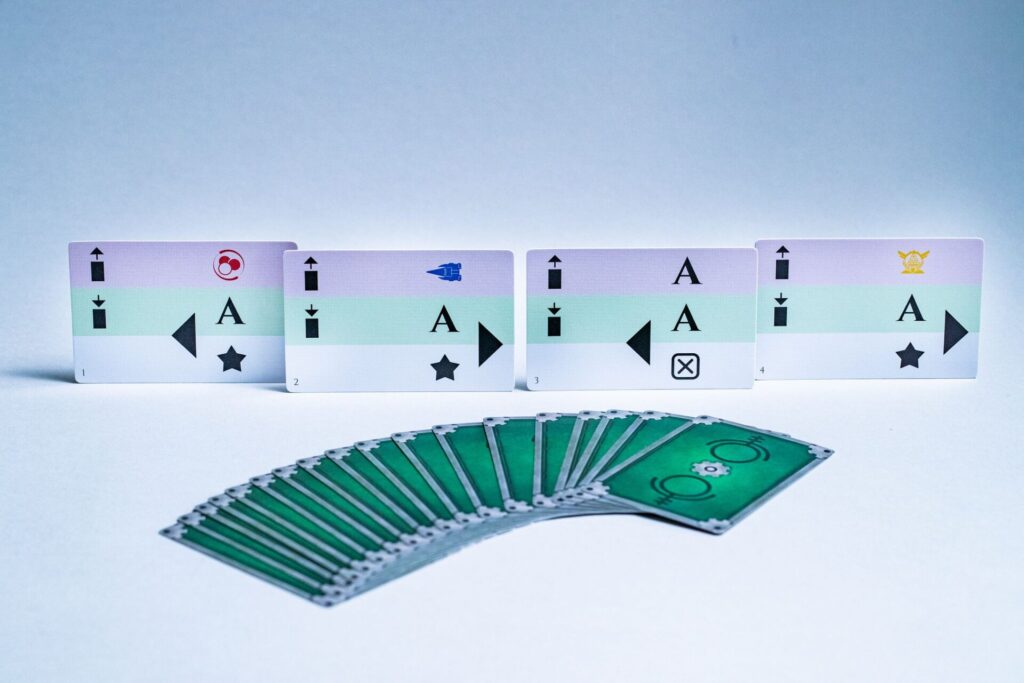
All that glitters…
Stonemaier were kind enough to send me the collector’s edition of the game. One of the major differences between this and the standard version is what the components are made of. The collector’s edition has metal cubes and pieces, which feel disgustingly satisfying to play with, but the colours on some of them are pretty difficult to tell apart. It shouldn’t be too much of a problem, but you’ll need to be wary of which rocket is which, and whose cubes are whose in the Institute if you’re playing with gold & copper, or pink & purple.
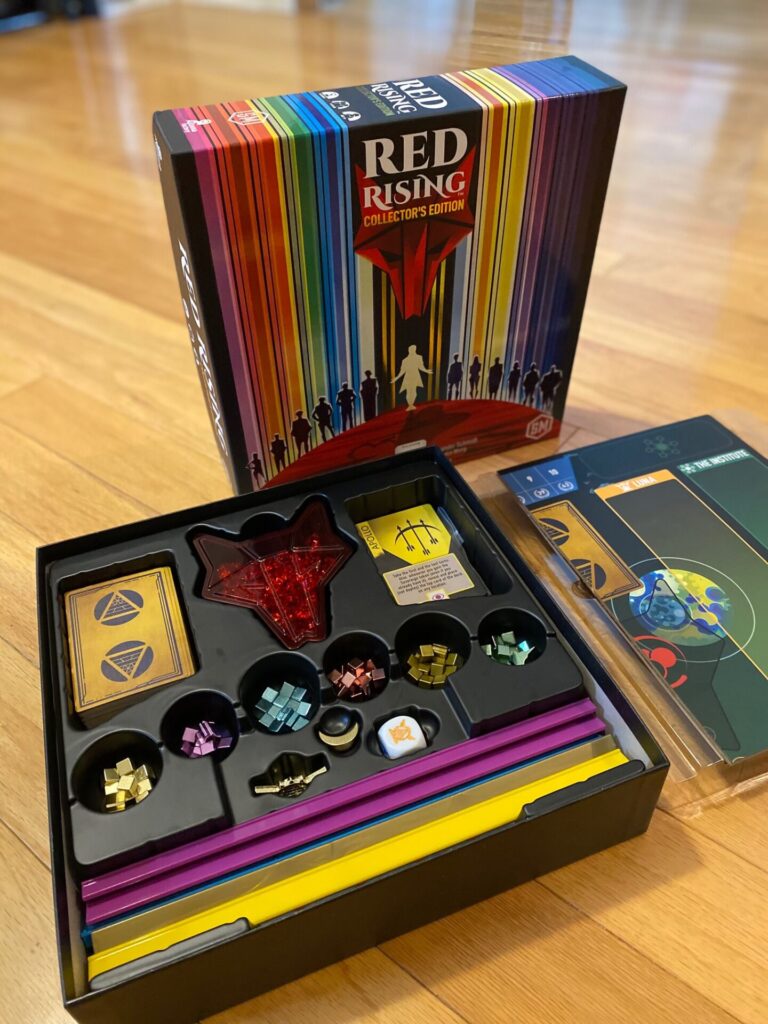
The cards are beautifully printed, and the gold leaf inlaid on the gold cards looks like an extravagance, but really adds to the polish. The colours problem rears its head here, with yellow and gold being very close, and again with brown and copper. If you’re worried about it from an accessibility point of view, you don’t need to. The names of the colours are written on each card. The collector’s edition even comes with card holders for each player. It’s unnecessary, but a nice touch.
Final Thoughts
Your first couple of plays of Red Rising can feel a bit overwhelming. Not because it’s difficult, but the sheer number of cards and colours makes it hard to come up with a plan. There are 112 unique character cards that you play with, and when you’re reading scoring descriptions that say things like they’re worth more points if Roque is in your hand, there’s a little disconnect until you’ve seen Roque and know who that is. I’ve heard some people complain that they think there are too many cards, and that you might need one that you never see. While that might be thing in a game like Everdell, where certain pre-set scoring events are dependent on a specific card, in Red Rising there are always another ten strategies you could be churning over in your brain.
I love how fast the game is, both to setup and to play. Games play out in less than an hour, so a best of three is easily possible in an evening, and you’ll probably want to play more than one game in a session. It’s really enjoyable placing cubes, taking the little helium gems, and sliding your little rocket along the fleet track. When you make a strong play that gives you loads of good stuff, and you just know you’ve screwed your rival at the same time, it’s extremely satisfying. There’s no obvious dominant strategy, which I think speaks to the level of love and attention the designers have poured into the game. The game was clearly a very personal project to Jamey, and all the designer notes in the rule book show just how much care has been lavished on the franchise and game.
Should you buy Red Rising?
Even as someone who has no idea who these characters, castes and locations are, I love the game. If you’re a fan of the franchise, I think it’s an insta-buy (if you haven’t already). Is it worth getting the collector’s edition? Honestly, it probably is. I mean, I wouldn’t feel like I’d missed out on anything with standard version, but the collector’s edition is cheaper than a lot of the standard editions of other Stonemaier Games.
If you’re looking to buy a new card game, and don’t want to pay through the nose for the latest LCG or CCG craze, then yes, you should get Red Rising. Absolutely. Unreservedly yes. I love Red Rising. It’s so simple and fast to play, but there is so much meta-game going on. Balancing what to keep, what to use, and when to use it, is delicious. Changing your mind half-way through the game on the revealing of just one card isn’t uncommon, and making that mental switch from playing cards to crafting a hand is a skill I think you’re only going to master with repeated play. And you will play it repeatedly. Red Rising is very addictive, and more importantly, it’s a lot of fun! If you want to try it out before buying it, you can play it right now on Tabletopia.
Review copy kindly provided by Stonemaier Games. Thoughts and opinions are my own.
Image Credits
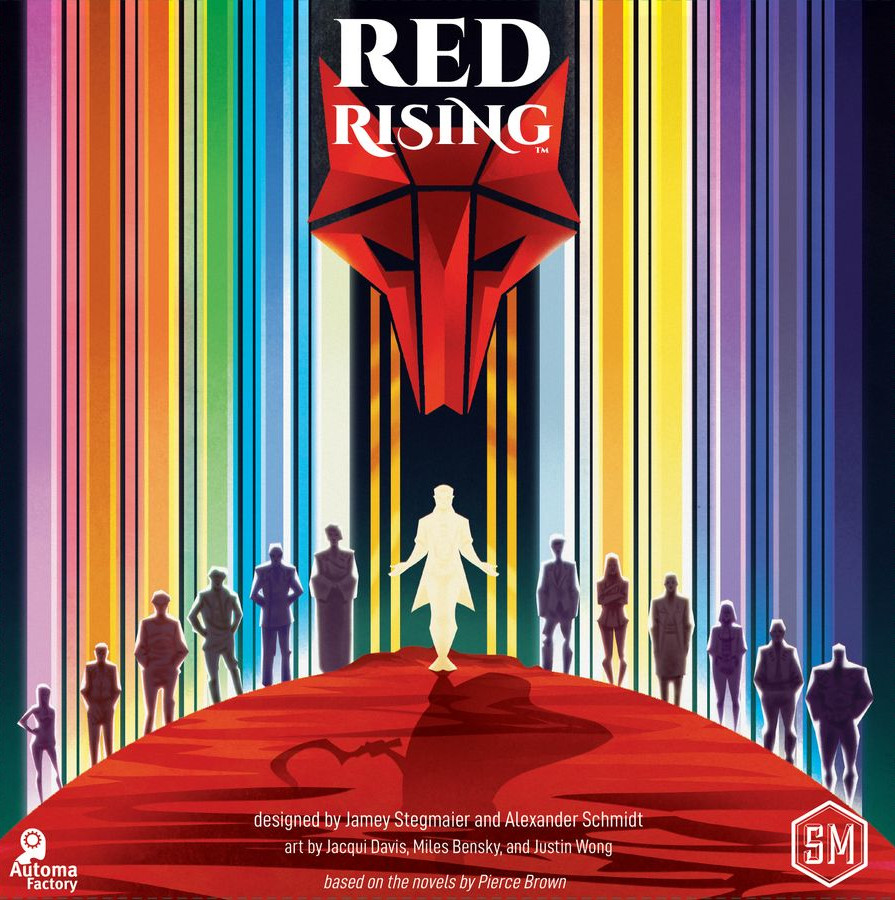
Red Rising (2021)
Designers: Jamey Stegmaier, Alexander Schmidt
Publisher: Stonemaier Games
Art: Jacqui Davis, Miles Bensky, Justin Wong
Players: 1-6
Playing time: 45-60 minutes

I have enjoyed my solos of this game a lot even though the solo feels quite different from a multiplayer game because the bot brings so many new cards into play. But I agree that the automa plays very smoothly.
In my single 2 player game, I got lucky with a pair of cards that came up (the Obsidian triplets one of which I held and another of which I managed to get onto the board with a yellow card) that allowed me to get two cards additional cards in hand in a single turn and more or less instantly assured my victory. I enjoy the game quite a bit and the beautiful materials do their own thing. But the triplets (even just two of them) really frustrated the other player.